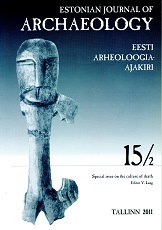COMMUNICATING ACROSS THE BORDER: WHAT BURIAL LAMENTS CAN TELL US ABOUT OLD BELIEFS
COMMUNICATING ACROSS THE BORDER: WHAT BURIAL LAMENTS CAN TELL US ABOUT OLD BELIEFS
Author(s): Madis ArukaskSubject(s): History
Published by: Teaduste Akadeemia Kirjastus
Keywords: COMMUNICATING ACROSS THE BORDER ; BURIAL LAMENTS ; ABOUT OLD BELIEFS ;
Summary/Abstract: The present article discusses how archaic cultures eliminated their fear of the dead; first and foremost in connection with laments as a folklore genre and lamenting as a ritual practice. Primarily, we examine the relevant Balto-Finnic and North Russian traditions, in which lamenting has retained its original function of balancing the relations between the spheres of the living and the dead, and of establishing borderlines, as well as of restoring the interrupted social cohesion. Lament texts can be viewed as a multifunctional genre that may even be addressed in various ways, but wherein nevertheless the interests of the community stand foremost, whereas personal psychological problems come only after, and related to them. The lamenter’s role and function in the society will be viewed, too. The second part of the article will, in connection with overcoming the fear of the dead, discuss exhumation – a phenomenon that has not been preserved in north European cultures but that can, in the light of treated bones or incomplete skeletons in the graves of Bronze and Iron Ages, be assumed to have at one time existed even in Estonia. In cultures where exhumation has remained a living practice up to the present (the Greek culture, for instance), it has probably also solved problems linked to the fear of the dead, since part of the person’s skeleton is posthumously reincorporated into the society of the living, in the shape of an amulet or a talisman. The relevant rituals have been performed to the accompaniment of laments. The final part of the article will take a look at certain textual examples of the Setu laments for the dead, which may have preserved a distant memory of the practices connected with exhumation.
Journal: Eesti Arheoloogia Ajakiri
- Issue Year: 15/2011
- Issue No: 2
- Page Range: 130-150
- Page Count: 21
- Language: English

